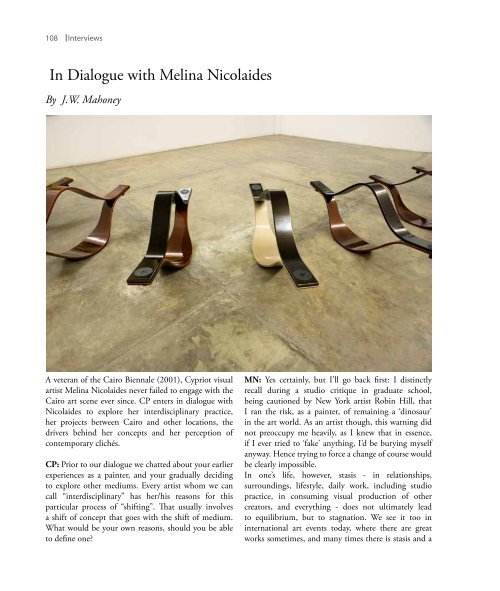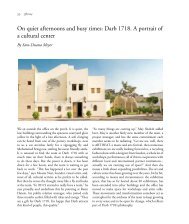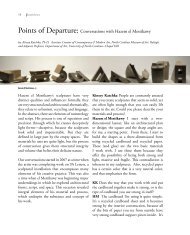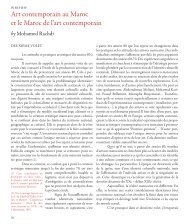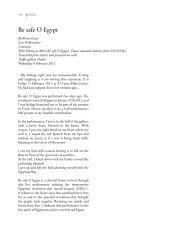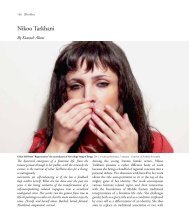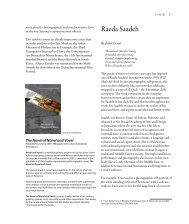In Dialogue with Melina Nicolaides - Contemporary Practices
In Dialogue with Melina Nicolaides - Contemporary Practices
In Dialogue with Melina Nicolaides - Contemporary Practices
You also want an ePaper? Increase the reach of your titles
YUMPU automatically turns print PDFs into web optimized ePapers that Google loves.
<strong>In</strong>terviews113voice and identity, and also find the strength to persevereafterwards in a state where the unknown becomes thereality and the road ahead of new beginnings is long.This satiated ‘breath of life’ reminds us that solidarity is,indeed, a beautiful and potent truth. It is a way we showour oneness <strong>with</strong> all of humanity; to liberate us from themundane human concerns of which Loukianos spoke.It is a way to reaffirm our own humanity in the socialand political situation of our times.Excerpt from ‘ON HOMO BULLA - LLA AYS’ byJ.W. Mahoney:“Beyond a certain point there is no return. This pointhas to be reached”Franz Kafka, from the Blue Octavo Notebooks, 1917-1919Whenever art and politics meet, usually one or theother wins - either art submits its visionary watchfulnesstoward the service of what appears to be a moralexpediency, or the dramatic content of serious politicsinspires an essentially private vision.Cypriot artist <strong>Melina</strong> <strong>Nicolaides</strong>’ 10 minute short film,‘Homo Bulla -18 Days’, fulfills both criteria: it offersa politically accurate symbolic vision of the EgyptianRevolution of early 2011, and has transformed thechaos, uncertainty, and proactive unity of those 18 daysinto a dynamic ballet of abstract forms, turning therhythms of those social forces into an unlikely set ofnatural images: bubbles of air rising as separate elementsand as masses, toward the ocean’s surface from deeperunderwater. <strong>Melina</strong> <strong>Nicolaides</strong> has been significantlyreceived internationally as an abstract painter, and assuch, her paintings have reflected a display of formsemerging from her personal interiority - so her new filmwork is a shift of both media and intention. <strong>In</strong> daily,sometimes hourly, contact <strong>with</strong> friends in Cairo duringthe revolution, the essentially darkly inspiring grace ofits crisis, and the beauty of its eventual success, madeart-making for <strong>Melina</strong>, <strong>with</strong> and around it, an openaesthetic necessity for her.As an abstractionist, <strong>Melina</strong>’s “characters” aren’t literalpeople, but bubbles. These forms are symbols ofpeople - who rise, move apart, coalesce, and rise again,no matter what is ahead of them. They emerge fromtheir underwater domain, an environment that hasbeen manipulated into a dark and grainy atmosphereof unidentifiable consistency, that befits the origins ofthis exodus towards a common purpose and aspiration.Below water, air will inevitably rise, as the people ofEgypt did, irrepressibly. And as Kafka suggested,this “point of no return” was, in fact, reached in thespring of 2011. The German cultural theorist PeterSloderdijk, has said, about these days: “A given culturenever possesses a complete vocabulary for itself..”. <strong>In</strong> theera between Plato and Leibniz almost everything to besaid about God and the world was expressed in terms ofa spherology. Think about the magical basic principleof medieval theosophy, which says, God is a spherewhose center is everywhere and whose circumference isnowhere. One could almost claim that the individualismof the modern era signifies an unconscious realizationof this dogma.” So <strong>Melina</strong> <strong>Nicolaides</strong> is using exactlythis form, a sphere, but in flux, in a progressive visualuncertainty, expressed as a series of bubbles - in anaesthetic language that implies both autonomy andfragility. And in ‘Homo Bulla’, <strong>Melina</strong> <strong>Nicolaides</strong> offers- allegorically - a number of issues at once: the graceof our individual fates’ power to create and survivecollective change, and the capacity of art to embraceand essentialize the reality we live in.We behold a progression of nearly sepia-toned bubbles,moving in directions that appear as natural as they areas naturally uncontrolled, flowing in unanticipatiblepatterns, toward an unmistakable reunion <strong>with</strong> its ownelement, air. <strong>Melina</strong> <strong>Nicolaides</strong>’ work looks like a rhythmof visual circumstances, at first. Groups of bubblesemerge from below, in groups, then away from eachother, sometimes. This is a clearly realized social poem- visually both beautifully complete and narratively astory whose end is left unfinished. Ultimately, what itsignifies is so culturally portentous - the continuingbeauty, and evanescence of each individual’s presence ina continually collective drama.It is 21st century art. For certain.J.W. MahoneyJ.W. Mahoney is an artist, writer, and independent curator whoserves as Washington’s Corresponding Editor for ‘Art in America’,and is Adjunct Professor of Visual Arts at the University ofMaryland in Baltimore. He has been writing and curating onthe idea of transmodernity since 1992.


